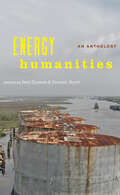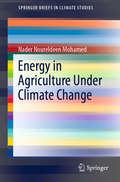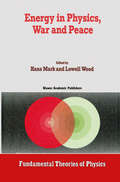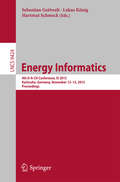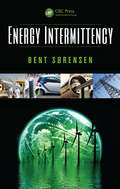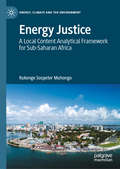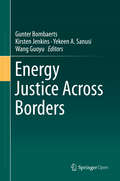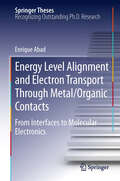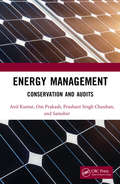- Table View
- List View
Energy Humanities: An Anthology
by Imre Szeman Dominic BoyerEnergy humanities is a field of scholarship that, like medical and digital humanities before it, aims to overcome traditional boundaries between the disciplines and between academic and applied research. Responding to growing public concern about anthropogenic climate change and the unsustainability of the fuels we use to power our modern society, energy humanists highlight the essential contribution that humanistic insights and methods can make to areas of analysis once thought best left to the natural sciences.In this groundbreaking anthology, Imre Szeman and Dominic Boyer have brought together a carefully curated selection of the best and most influential work in energy humanities. Arguing that today;€™s energy and environmental dilemmas are fundamentally problems of ethics, habits, imagination, values, institutions, belief, and power;¢;‚¬;€?all traditional areas of expertise of the humanities and humanistic social sciences;¢;‚¬;€?the essays and other pieces featured here demonstrate the scale and complexity of the issues the world faces. Their authors offer compelling possibilities for finding our way beyond our current energy dependencies toward a sustainable future.Contributors include: Margaret Atwood, Paolo Bacigalupi, Lesley Battler, Ursula Biemann, Dominic Boyer, Italo Calvino, Warren Cariou, Dipesh Chakrabarty, Una Chaudhuri, Claire Colebrook, Stephen Collis, Erik M. Conway, Amy De;€™Ath, Adam Dickinson, Fritz Ertl, Pope Francis, Amitav Ghosh, G;¶k;§e G;¼nel, Gabrielle Hecht, Cymene Howe, Dale Jamieson, Julia Kasdorf, Oliver Kellhammer, Stephanie LeMenager, Barry Lord, Graeme Macdonald, Joseph;‚ Masco, John McGrath, Martin McQuillan, Timothy Mitchell, Timothy Morton, Jean-Fran;§ois Mouhot, Abdul Rahman Munif, Judy Natal, Reza Negarestani, Pablo Neruda, David Nye, Naomi Oreskes, Andrew Pendakis, Karen Pinkus, Ken Saro-Wiwa, Hermann Scheer, Roy Scranton, Allan Stoekl, Imre Szeman, Laura Watts, Michael Watts, Jennifer Wenzel, Sheena Wilson, Patricia Yaeger, and Marina Zurkow
Energy Humanities: An Anthology
by Imre Szeman Dominic BoyerEnergy humanities is a field of scholarship that, like medical and digital humanities before it, aims to overcome traditional boundaries between the disciplines and between academic and applied research. Responding to growing public concern about anthropogenic climate change and the unsustainability of the fuels we use to power our modern society, energy humanists highlight the essential contribution that humanistic insights and methods can make to areas of analysis once thought best left to the natural sciences.In this groundbreaking anthology, Imre Szeman and Dominic Boyer have brought together a carefully curated selection of the best and most influential work in energy humanities. Arguing that today;€™s energy and environmental dilemmas are fundamentally problems of ethics, habits, imagination, values, institutions, belief, and power;¢;‚¬;€?all traditional areas of expertise of the humanities and humanistic social sciences;¢;‚¬;€?the essays and other pieces featured here demonstrate the scale and complexity of the issues the world faces. Their authors offer compelling possibilities for finding our way beyond our current energy dependencies toward a sustainable future.Contributors include: Margaret Atwood, Paolo Bacigalupi, Lesley Battler, Ursula Biemann, Dominic Boyer, Italo Calvino, Warren Cariou, Dipesh Chakrabarty, Una Chaudhuri, Claire Colebrook, Stephen Collis, Erik M. Conway, Amy De;€™Ath, Adam Dickinson, Fritz Ertl, Pope Francis, Amitav Ghosh, G;¶k;§e G;¼nel, Gabrielle Hecht, Cymene Howe, Dale Jamieson, Julia Kasdorf, Oliver Kellhammer, Stephanie LeMenager, Barry Lord, Graeme Macdonald, Joseph;‚ Masco, John McGrath, Martin McQuillan, Timothy Mitchell, Timothy Morton, Jean-Fran;§ois Mouhot, Abdul Rahman Munif, Judy Natal, Reza Negarestani, Pablo Neruda, David Nye, Naomi Oreskes, Andrew Pendakis, Karen Pinkus, Ken Saro-Wiwa, Hermann Scheer, Roy Scranton, Allan Stoekl, Imre Szeman, Laura Watts, Michael Watts, Jennifer Wenzel, Sheena Wilson, Patricia Yaeger, and Marina Zurkow
Energy Impacts: A Multidisciplinary Exploration of North American Energy Development
by Jeffrey B. Jacquet Julia H. Haggerty Gene L. TheodoriDevelopment of various energy sources continues across North America and around the world, raising questions about social and economic consequences for the places and communities where these activities occur. Energy Impacts brings together important new research on site-level social, economic, and behavioral impacts from large-scale energy development. Featuring conceptual and empirical multidisciplinary research from leading social scientists, the volume collects a broad range of perspectives to understand North America’s current energy uses and future energy needs. Twelve chapters from respected scholars in a variety of disciplines present new ways to consider and analyze energy impact research. Focused on varied energy topics, geographies, and disciplines, each chapter includes a policy brief that summarizes the work and provides “key takeaways” to apply the findings to policy and public discourse. Meaningful public engagement is critical in limiting the negative implications of energy development, and understanding the social influences on and of energy systems is a cornerstone of addressing the climate crisis. As such, Energy Impacts is a significant work for students, scholars, and professionals working in sociology, education, geography, environmental studies, and public health. This material is based upon work supported by the National Science Foundation under Grant No. 1528422. Publication is also supported, in part, by Montana State University. Contributors: Ali Adil, Lisa Bailey-Davis, Nancy Bowen-Elizey, Morey Burnham, Weston Eaton, Heather Feldhaus, Felix Fernando, Emily Grubert, C. Clare Hinrichs, John Hintz, Richard Hirsh, Season Hoard, Tamara Laninga, Eric Larson, Achla Marathe, Natalie Martinkus, Seven Mattes, Ronald Meyers, Patrick Miller, Ethan Minier, Myra Moss, Jacob Mowery, Thomas Murphy, Sevda Ozturk Sari, John Parkins, Christopher Podeschi, Nathan Ratledge, Sanne Rijkhoff, Kelli Roemer, Todd Schenk, Anju Seth, Kate Sherren, Jisoo Sim, Marc Stern, Jessica Ulrich-Schad, Cameron Whitley, Laura Zachary
Energy in Agriculture Under Climate Change (SpringerBriefs in Climate Studies)
by Nader Noureldeen MohamedThis book discusses the role of energy in agriculture which reaches 30%, and the role of agriculture in energy where the water shred by 17% in total electricity generation in addition to the role of bioenergy as a source of liquid energy. Climate change and global heating will increase the temperature and that will affect plant growth, water availability and the share of electricity in agriculture and other energy phases in agriculture. Global heating means more water pumping, more uses of fertilizers and pesticides in which intensive power consumption in addition to need of more electricity for air-condition inside the greenhouses, the manufacturing of hormone and plant growth organizers will also consume more energy. Finally, the book explains why the water, energy and food become one nexus and the interaction and interference between them.This book will have valuable information for both students and faculties of engineering and agriculture in addition to research centers, water institutions and climate change specialists.
Energy in Australia: Peak Oil, Solar Power, and Asia’s Economic Growth (SpringerBriefs in Energy)
by Graham PalmerWith rapidly declining costs and seemingly unlimited sunshine, the choice of solar in Australia seems obvious. Yet despite its many advantages, homes with solar remain completely dependent on the electricity grid for reliable supply, which in Australia implies mostly coal-fired generation. Indeed, even countries that have invested heavily in solar, such as Spain and Germany, have been unable to deflect the trajectory of fossil fuel dependence.The reasons for this apparent paradox are varied, and this book provides a deeper and more nuanced understanding of the practical applications of photovoltaics (PV) in modern electricity systems. While the conventional life-cycle assessment (LCA) boundaries as prescribed by the IEA-PVPS provide a consistent methodology for comparing evolving PV technologies, the narrow boundaries exclude many critical downstream energy costs. Similarly, simple cost comparisons of PV versus conventional power sources overlook the significant economic and energy costs of intermittency and grid integration. Yet distributed storage, which could provide potentially valuable network support, is frequently given a low priority by advocates of solar.Treating PV as an extension of, rather than as a substitute for, the fossil fuel enterprise enables a more productive discussion of PV’s potential role in electricity generation. The sunburnt country of Australia, which has a modern electricity system, is an ideal case study for exploring the potential of solar PV. With a focus on rooftop solar, energy storage, grid integration, and electricity system issues, Energy in Australia offers valuable insights into the practical challenges of solar power. Although many national economies are already confronting a downward trend in energy return on investment (EROI) of oil and gas from both conventional and unconventional sources, the large-scale deployment of low-emission energy sources that lie below a critical minimum EROI threshold may ultimately prove counter-productive.
Energy in Perspective
by Mark CronshawThis textbook provides broad coverage of energy supply and use. It discusses how energy is produced, transformed, delivered to end users, and consumed. The author discusses all of this at an undergraduate level, accessible to students of varying backgrounds. High-level and human-scale perspectives are included. As a high-level example, the book discusses the shares of global primary energy that are provided by oil, gas, coal, hydroelectricity, and renewables, as well as trends in energy consumption and supply over time. Human-scale examples will resonate with readers’ every day experiences. The link between economic development and energy consumption is presented, which facilitates understanding of how global energy consumption growth is inevitable as economic development occurs. Coverage includes separate chapters on the oil, natural gas, coal, and electricity sectors. Each of these provides high-level descriptions of the technology involved in the production of that type of energy as well as the processing and transportation that occurs to bring the energy to end users. The book discusses the technological implications of energy transitions such as increased use of renewables or changes in the use of nuclear energy using Germany and Japan as examples. It closes with a discussion of future energy use.
Energy in Physics, War and Peace: A Festschrift Celebrating Edward Teller’s 80th Birthday (Fundamental Theories of Physics #30)
by Hans Mark Lowell WoodWriting even in overview of more than a half-century of professional life of a giant of twentieth century science and technology such as Edward Teller is a daunting task. We ask in advance the reader's pardon for passing over quickly or omitting entirely aspects of Teller's life and work which may seem of major significance but which we, due to differences of perspective or knowledge, speak too little or not at all. We refer those interested in greater depth to the excellent biography by Stanley Blumberg and Gwen Owens, The Life and Times of Edward Teller, and we have (with his permission) printed Professor Eugene Wigner's An Appreciation On the 60th Birthday of Edward Teller immediately after this foreword, so that the reader may consider the perspective of one of Teller's most illustrious contemporaries more than two decades ago. Edward Teller was born in Budapest, Hungary on January 15,1908. While his childhood was spent in the twilight of the Victorian age and its abrupt conclusion in the Great War and his youth in its especially turbulent after math in central Europe, he doesn't bear visible scars from it.
Energy Independence: The Individual Pursuit of Energy Freedom (River Publishers Series in Energy Sustainability and Efficiency)
by Alden M Hathaway, II Tripp HathawayThe 20th century is known to the entire world as a century of American greatness. Innovations in energy drove that American superiority; innovations such as oil pipelines, petroleum-based fuel, the light bulb, electricity, and the power grid. However, our legacy energy economy leaves us wanting in the 21st century. Centralized vulnerability, wasted generation capacity, dependence on foreign fuel, and climate change are financed by every one of us at the pump and in our monthly utility bill. However, "Energy Independence" is not about what is wrong with our current energy economy; rather it describes a bright future that is waiting to be unlocked. It presents a plan where the average homeowner can not only achieve energy freedom for their household, but usher in the new energy economy.
Energy Independence: The Individual Pursuit of Energy Freedom (River Publishers Series in Energy Sustainability and Efficiency)
by Alden M Hathaway, II Tripp HathawayThe 20th century is known to the entire world as a century of American greatness. Innovations in energy drove that American superiority; innovations such as oil pipelines, petroleum-based fuel, the light bulb, electricity, and the power grid. However, our legacy energy economy leaves us wanting in the 21st century. Centralized vulnerability, wasted generation capacity, dependence on foreign fuel, and climate change are financed by every one of us at the pump and in our monthly utility bill. However, "Energy Independence" is not about what is wrong with our current energy economy; rather it describes a bright future that is waiting to be unlocked. It presents a plan where the average homeowner can not only achieve energy freedom for their household, but usher in the new energy economy.
Energy Informatics: 4th D-A-CH Conference, EI 2015, Karlsruhe, Germany, November 12-13, 2015, Proceedings (Lecture Notes in Computer Science #9424)
by Sebastian Gottwalt Lukas König Hartmut SchmeckThis book constitutes the refereed proceedings of the 4th D-A-CH Conference on Energy Informatics, D-A-CH EI 2015, held in Karlsruhe, Germany, in November 2015.The 18 revised full papers presented were carefully reviewed and selected from 36 submissions. The papers are organized in topical sections on distributed energy sources and storage, smart meters and monitoring, research lab infrastructures, electric mobility, communication and security, and modeling and simulation.
Energy, Information, Feedback, Adaptation, and Self-organization: The Fundamental Elements of Life and Society (Intelligent Systems, Control and Automation: Science and Engineering #90)
by Spyros G TzafestasThis unique book offers a comprehensive and integrated introduction to the five fundamental elements of life and society: energy, information, feedback, adaptation, and self-organization. It is divided into two parts. Part I is concerned with energy (definition, history, energy types, energy sources, environmental impact); thermodynamics (laws, entropy definitions, energy, branches of thermodynamics, entropy interpretations, arrow of time); information (communication and transmission, modulation–demodulation, coding–decoding, information theory, information technology, information science, information systems); feedback control (history, classical methodologies, modern methodologies); adaptation (definition, mechanisms, measurement, complex adaptive systems, complexity, emergence); and self-organization (definitions/opinions, self-organized criticality, cybernetics, self-organization in complex adaptive systems, examples in nature). In turn, Part II studies the roles, impacts, and applications of the five above-mentioned elements in life and society, namely energy (biochemical energy pathways, energy flows through food chains, evolution of energy resources, energy and economy); information (information in biology, biocomputation, information technology in office automation, power generation/distribution, manufacturing, business, transportation), feedback (temperature, water, sugar and hydrogen ion regulation, autocatalysis, biological modeling, control of hard/technological and soft/managerial systems), adaptation and self-organization (ecosystems, climate change, stock market, knowledge management, man-made self-organized controllers, traffic lights control).
Energy Intermittency
by Bent SorensenThe first book to consider intermittency as a key point of an energy system, Energy Intermittency describes different levels of variability for traditional and renewable energy sources, presenting detailed solutions for handling energy intermittency through trade, collaboration, demand management, and active energy storage. Addressing energy supply intermittency systematically, this practical text: Analyzes typical time-distributions and intervals between episodes of demand-supply mismatch and explores their dependence on system layouts and energy source characteristics Simulates scenarios regarding resource time-flow, energy conversion devices, and demand structure to assist in evaluating the technical viability of the proposed solutions Discusses the conditions for establishing such systems in terms of economic requirements and regulatory measures In one concise and convenient volume, Energy Intermittency provides a comprehensive overview of all the causes and remedies of energy supply intermittency.
Energy Intermittency
by Bent SorensenThe first book to consider intermittency as a key point of an energy system, Energy Intermittency describes different levels of variability for traditional and renewable energy sources, presenting detailed solutions for handling energy intermittency through trade, collaboration, demand management, and active energy storage. Addressing energy supply intermittency systematically, this practical text: Analyzes typical time-distributions and intervals between episodes of demand-supply mismatch and explores their dependence on system layouts and energy source characteristics Simulates scenarios regarding resource time-flow, energy conversion devices, and demand structure to assist in evaluating the technical viability of the proposed solutions Discusses the conditions for establishing such systems in terms of economic requirements and regulatory measures In one concise and convenient volume, Energy Intermittency provides a comprehensive overview of all the causes and remedies of energy supply intermittency.
Energy Investments: An Adaptive Approach to Profiting from Uncertainties
by Ricardo G. BarcelonaThis book examines what lies behind the uncertainties surrounding the fuel and power markets. Exploring the role of renewables and how they potentially disrupt or create opportunities, it challenges widely accepted wisdoms in investment. The author asks questions such as: Are “business as usual” strategies that favour fossil fuels the best route to future prosperity? What prospects do firms face when their competitors diversify into renewables? Why do generous subsidies to renewables often fail to achieve wide-scale deployment? Illustrating how real options and option games reasoning yield vastly different insights from those gained from NPVs, Energy Investments offers case studies and simulations to demonstrate how firms can benefit from the methods it showcases.
Energy Issues and Transition to a Low Carbon Economy: Insights from Mexico (Strategies for Sustainability)
by Francisco J. Lozano Alberto Mendoza Arturo MolinaWithout energy, there is no well-functioning economy, besides facing social risks. This book provides a systemic approach to energy in Mexico and its relations to the USA arising from the energy reform of the former. It covers the transition from fossil fuels to a low-carbon economy, relying heavily on renewable sources and mitigating climate change risks. Several human knowledge disciplines and topics are covered in the book, including public policy, economics, transboundary issues, electricity and thermal energy, residual biomass use, distributed energy systems and its management, and decision-making tools. An analysis is considered regarding energy issues interaction in the Mexican-USA border, which differ in both countries from pricing and policy, and the work and research that has been developed for transboundary energy trade.
Energy Justice: A Local Content Analytical Framework for Sub-Saharan Africa (Energy, Climate and the Environment)
by Rukonge Sospeter MuhongoThis book explores local content policies and their role in natural resource management within the realm of energy justice. Based on several country case studies it discusses the role of regional integration for such policies in Sub-Saharan Africa. Energy justice has been widely applied across different aspects of development, but here the principles of justice are specifically integrated with the management and implementation of oil and gas projects. Such an analysis offers novel means of implementing policies in local regions, moving away from a one-size fits all approach that leads to the ineffective transplantation of policies from developed economies to developing Sub-Saharan economies. The book argues that with a regional approach, Sub-Saharan Africa can leverage natural resources, industrial parks, supplier clusters, regional financing mechanisms and regional training facilities which would drive down the costs of production, increase efficiency and integrate the local Sub-Saharan population into the oil and gas industry. This would result in the benefits as well as the environmental concerns and responsibilities intrinsic to these industries, being spread more equally amongst local and none local stakeholders. This book will be a valuable resource for scholars and students as well as policy makers and practitioners in the areas of extractive industry-related disciplines energy governance, and economic development in Africa.
Energy Justice Across Borders
by Gunter Bombaerts Kirsten Jenkins Yekeen A. Sanusi Wang GuoyuThis book is open access under a CC BY 4.0 license.We must find new and innovative ways of conceptualizing transboundary energy issues, of embedding concerns of ethics or justice into energy policy, and of operationalizing response to them. This book stems from the emergent gap; the need for comparative approaches to energy justice, and for those that consider ethical traditions that go beyond the classical Western approach. This edited volume unites the fields of energy justice and comparative philosophy to provide an overarching global perspective and approach to applying energy ethics. We contribute to this purpose in four sections: setting the scene, practice, applying theory to practice, and theoretical approaches. Through the chapters featured in the volume, we position the book as one that contributes to energy justice scholarship across borders of nations, borders of ways of thinking and borders of disciplines. The outcome will be of interest to undergraduate and graduate students studying energy justice, ethics and environment, as well as energy scholars, policy makers, and energy analysts.
The Energy Landscape in the Republic of South Africa (SpringerBriefs in Energy)
by Bruno G. Pollet Ian Staffell Kerry-Ann AdamsonA timely overview of the energy landscape in South Africa (RSA) is presented in this Springerbrief. The background and context to the current situation, and analysis of the policies being put forward by the government for the near future are described. Four broad areas are covered: reserves and production of fossil fuels, the electricity sector, the rapidly growing exploitation of renewable energy, and the recent push towards developing an industry around hydrogen and fuel cells. This Springerbrief presents a methodical review of the energy landscape in RSA, covering the general situation, the supply and demand for energy, and the structure of the energy sector (Chapters 1&2). Chapter 3 presents data and analysis of the country’s fossil fuels, electricity generation, and the chemistry of green, future sources of energy, production and the role of industry. Chapter 4 discusses recent developments, including the impact on green jobs and green funds, and Chapter 5 reflects on the policies that have been proposed and their potential implications.
Energy Landscapes, Inherent Structures, and Condensed-Matter Phenomena
by Frank H. StillingerThis book presents an authoritative and in-depth treatment of potential energy landscape theory, a powerful analytical approach to describing the atomic and molecular interactions in condensed-matter phenomena. Drawing on the latest developments in the computational modeling of many-body systems, Frank Stillinger applies this approach to a diverse range of substances and systems, including crystals, liquids, glasses and other amorphous solids, polymers, and solvent-suspended biomolecules.Stillinger focuses on the topography of the multidimensional potential energy hypersurface created when a large number of atoms or molecules simultaneously interact with one another. He explains how the complex landscape topography separates uniquely into individual "basins," each containing a local potential energy minimum or "inherent structure," and he shows how to identify interbasin transition states—saddle points—that reside in shared basin boundaries. Stillinger describes how inherent structures and their basins can be classified and enumerated by depth, curvatures, and other attributes, and how those enumerations lead logically from vastly complicated multidimensional landscapes to properties observed in the real three-dimensional world.Essential for practitioners and students across a variety of fields, the book illustrates how this approach applies equally to systems whose nuclear motions are intrinsically quantum mechanical or classical, and provides novel strategies for numerical simulation computations directed toward diverse condensed-matter systems.
Energy Level Alignment and Electron Transport Through Metal/Organic Contacts: From Interfaces to Molecular Electronics (Springer Theses)
by Enrique AbadIn recent years, ever more electronic devices have started to exploit the advantages of organic semiconductors. The work reported in this thesis focuses on analyzing theoretically the energy level alignment of different metal/organic interfaces, necessary to tailor devices with good performance. Traditional methods based on density functional theory (DFT), are not appropriate for analyzing them because they underestimate the organic energy gap and fail to correctly describe the van der Waals forces.Since the size of these systems prohibits the use of more accurate methods, corrections to those DFT drawbacks are desirable. In this work a combination of a standard DFT calculation with the inclusion of the charging energy (U) of the molecule, calculated from first principles, is presented. Regarding the dispersion forces, incorrect long range interaction is substituted by a van der Waals potential. With these corrections, the C60, benzene, pentacene, TTF and TCNQ/Au(111) interfaces are analyzed, both for single molecules and for a monolayer. The results validate the induced density of interface states model.
Energy-Level Control at Hybrid Inorganic/Organic Semiconductor Interfaces (Springer Theses)
by Raphael SchlesingerThis work investigates the energy-level alignment of hybrid inorganic/organic systems (HIOS) comprising ZnO as the major inorganic semiconductor. In addition to offering essential insights, the thesis demonstrates HIOS energy-level alignment tuning within an unprecedented energy range. (Sub)monolayers of organic molecular donors and acceptors are introduced as an interlayer to modify HIOS interface-energy levels. By studying numerous HIOS with varying properties, the author derives generally valid systematic insights into the fundamental processes at work. In addition to molecular pinning levels, he identifies adsorption-induced band bending and gap-state density of states as playing a crucial role in the interlayer-modified energy-level alignment, thus laying the foundation for rationally controlling HIOS interface electronic properties. The thesis also presents quantitative descriptions of many aspects of the processes, opening the door for innovative HIOS interfaces and for future applications of ZnO in electronic devices.
Energy Limits in Computation: A Review of Landauer’s Principle, Theory and Experiments
by Craig S. Lent Alexei O. Orlov Wolfgang Porod Gregory L. SniderThis book is a single-source reference to the issues involved in the Landauer principle, which has gained new prominence recently, due to the large amount of heat generated by today’s computers. If Landauer’s principle is correct, there may be ways to build computers that dissipate far less power (corresponding to heat generated) than today’s computers. This book brings together all sides of the discussions regarding Landauer’s principle, both theoretical and experimental, empowering readers to gain better understanding of dissipation in computation, and the limits if any to progress in computation related to energy dissipation. It represents the best and most thorough examination of the important issue of Landauer’s principle that is available in one volume.Provides an in-depth investigation of the Landauer principle and how it relates to the possible existence of lower bounds on dissipation in computation;Gathers together both sides of the discussion: those who agree with Landauer and his conclusions, and those who think that Landauer was not correct, offering fresh perspective on the issues in the new light of experiments;Offers insight into the future of silicon CMOS and the limits if any to progress in computation related to energy dissipation.
Energy Management: Big Data in Power Load Forecasting
by Valentin A. BoiceaThis book introduces the principle of carrying out a medium-term load forecast (MTLF) at power system level, based on the Big Data concept and Convolutionary Neural Network (CNNs). It also presents further research directions in the field of Deep Learning techniques and Big Data, as well as how these two concepts are used in power engineering. Efficient processing and accuracy of Big Data in the load forecast in power engineering leads to a significant improvement in the consumption pattern of the client and, implicitly, a better consumer awareness. At the same time, new energy services and new lines of business can be developed. The book will be of interest to electrical engineers, power engineers, and energy services professionals.
Energy Management: Big Data in Power Load Forecasting
by Valentin A. BoiceaThis book introduces the principle of carrying out a medium-term load forecast (MTLF) at power system level, based on the Big Data concept and Convolutionary Neural Network (CNNs). It also presents further research directions in the field of Deep Learning techniques and Big Data, as well as how these two concepts are used in power engineering. Efficient processing and accuracy of Big Data in the load forecast in power engineering leads to a significant improvement in the consumption pattern of the client and, implicitly, a better consumer awareness. At the same time, new energy services and new lines of business can be developed. The book will be of interest to electrical engineers, power engineers, and energy services professionals.
Energy Management: Conservation and Audits
by Anil Kumar Om Prakash Prashant Singh Chauhan Samsher GautamEnergy Management: Conservation and Audit discusses the energy scenario, including energy conservation, management, and audit, along with the methodology supported by industrial examples. Energy economics of systems has been elaborated with concepts of life cycle assessment and costing, and rate of return. Topics such as energy storage, co-generation, and waste heat recovery to energy efficiency have discussed. The challenges faced in conserving energy sources (steam and electricity) have elaborated along with the improvements in the lighting sector. Further, it covers optimization procedures for the development in the industry related to energy conservation. The researchers, senior undergraduate, and graduate students focused on Energy Management, Sustainable Energy, Renewable Energy, Energy Audits, and Energy Conservation. This book covers current information related to energy management and includes energy audit and review all the leading equipment (boilers, CHP, pumps, heat exchangers) as well as procedural frameworks (energy audits, action planning, monitoring). It includes energy production and management from an industrial perspective, along with highlighting the various processes involved in energy conservation and auditing in various sectors and associated methods. It also explores future energy options and directions for energy security and sustainability.
